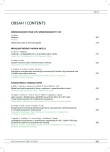Progressive Necrotizing Myelopathy – a Case Report
Authors:
I. Lisá 1; V. Belan 2; D. Podhoranská 1
Authors‘ workplace:
II. Neurologická klinika LF UK a FNsP Bratislava, 2Radiodiagnostická klinika SZU a FNsP Bratislava
1
Published in:
Cesk Slov Neurol N 2009; 72/105(3): 265-269
Category:
Case Report
Overview
Progressive necrotizing myelopathy is an extremely rare disease, even considered among non-compressive myelopathies. Spinal cord symptoms are characteristic of it, with the peripheral motor neuron severely affected. A typical cerebrospinal fluid finding is increased total protein without oligoclonal bands, sometimes with mild pleocytosis. A specific MRI criterion is the involvement of at least three or more neighbouring vertebral spinal cord segments with hypersignal in the TW2 picture and gadolinium enhancement, evolving over months into atrophy, which corresponds to spinal cord necrosis confirmed on bioptic examination. The range of differential diagnosis is wide. Apart from other more common diseases (multiple sclerosis, inflammatory, neoplastic, systemic, vascular and metabolic causes of myelopathy), rare paraneoplastic spinal cord involvement must also be excluded. Recently, autoimmune pathogenetic mechanisms related to neuromyelitis optica have been considered, based on the occurrence of specific NMO IgG antibodies against aquaporin 4. The disease has a progressive course, although immunomodulatory treatment may possibly prove therapeutic. The authors present the case report of a 67-year-old man with noticeably atopic terrain revealed on immunological examination, fulfilling clinical and MRI criteria for progressive necrotizing myelopathy. Treatment with corticoids had no effect and was therefore followed by intravenous immunoglobulins, which resulted in a temporary improvement in the clinical condition and an improvement in the serious motor deficiency. Two years after the first manifestation of neurological symptoms, a conventional type of carcinoma was diagnosed in the patient from gr. II WHO kidney cells. As a consequence, in spite of repeated negative findings for antineuronal antibodies, we have to consider a possible paraneoplastic origin for the progressive necrotizing myelopathy.
Key words:
progressive necrotizing myelopathy – neuromyelitis optica – paraneoplastic syndrome – intravenous immunoglobulins
Sources
1. Darnell RB, Posner JB. Paraneoplastic syndromes involving the nervous system. N Engl J Med 2003; 349(16): 1543-1554.
2. Grisold W, Lutz D, Wolf P. Necrotizing myelopathy associated with acute lymphoblastic leukemia. Case report and review of literature. Acta Neuropathol 1980; 49(3): 231-235.
3. Storey E, McKelview PA. Necrotizing myelopathy associated with multiple myeloma. Acta Neurol Scand 1991; 84(2): 98-101.
4. Iwanesa T, Utsumi Z, Sakuda H, Yoshitake H, Kakazu T, Kubota R et al. Two cases of necrotizing myelopathy associated with malignancy caused by herpes simplex virus type 2. Acta Neuropathol 1989; 78(3): 252-257.
5. Wiley CA, VanPatten PD, Carpenter PM, Powell HC, Thal LJ. Acute ascending necrotizing myelopathy caused by virus herpes simplex type 2. Neurology 1987; 37(11): 1791-1794.
6. Ashraf VV, John MM, Ramakrishnan KG, Mahadevan A. Relapsing myelopathy as the initial manifestation of primary central nervous system angiitis. Neurol India 2007; 55(4): 425-427.
7. Katz JD, Ropper AH. Progressive necrotic myelopathy: clinical course in 9 patients. Arch Neurol 2000; 57(3): 355-361.
8. Okai AF, Muppidi S, Bagla R, Leist TP. Progressive necrotizing myelopathy :part of the spectrum of neuromyelitis optica? Neurol Res 2006; 28(3): 354–359.
9. Prabhakar S, Syal P, Singh P, Lal V, Khandelwal N, Das CP. Non-compressive myelopathy: clinical and radiological study. Neurol India 1999; 47(4): 294-299.
10. Parmar RC, Bavdekar SB, Sira P, Kamat JR. Necrotizing myelitis in an immunocompetent child: a case report with review of literature. J Med Sci 2003; 57(12): 556-558.
11. Jarius S, Friedman P, Franciotta D, Waters P, Zipp F, Hohlfeld R et al. Mechanisms of disease: aquaporin-4 antibodies in neuromyelitis optica. Nat Clin Pract Neurol 2008; 4(4): 202-214.
12. Mirich DR, Kucharczyk W, Keller MA, Deck J. Subacute necrotizing myelopathy: MR imaging in four pathologically proven cases. AJNR Am J Neuroradiol 1991; 12(6): 1077-1083.
13. Graus F, Delattre JY, Antoine JC, Dalmau J, Giometto B, Grisold W et al. Recommended diagnostic criteria for paraneoplastic neurological syndromes. J Neurol Neurosurg Psychiatry 2004; 75(8): 1135-1140.
14. Kaušitz J. Význam a postavenie nádorových markerov v skríningu,diagnostike a sledovaní pacientov v onkológii. Onkológia 2006; 1(3): 155-158.
15. Palapattu GS, Kristo B, Rajfer J. Paraneoplastic syndromes in urologic malignancy: the many faces of renal cell carcinoma. Rev Urol 2002; 4(4): 163–170.
16. Mancall EL, Rosales RK. Necrotizing myelopathy associated with visceral carcinoma. Brain 1964; 87: 639–656.
17. Mueller S, Dubal DB, Josephson A. A case of paraneoplastic myelopathy associated with the neuromyelitis optica antibody. Nat Clin Pract Neurol 2008; 4(5): 284-288.
18. Evans BK, Fagan C, Arnold T, Dropcho EJ, Oh SJ. Paraneoplastic motor neuron disease and renal cell carcinoma: improvement after nephrectomy. Neurology 1990; 40(6): 960-962.
Labels
Paediatric neurology Neurosurgery NeurologyArticle was published in
Czech and Slovak Neurology and Neurosurgery

2009 Issue 3
Most read in this issue
- Autologo us Hematopo i etic Stem Cells Transplantati on and its Current Role in Multiple Sclerosis Tre atment
- Migraine
- Adult Form of Glutaric Aciduri a Type II – Under di agnosed Ca useof Proximal Myopathy – a Case Report
- Transfer of the Tibial Posteri or Muscle Tendon – Effici ent Soluti on to Perone al Muscular Paresis
